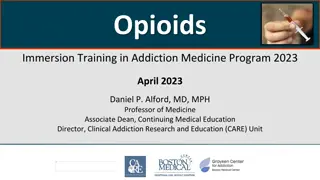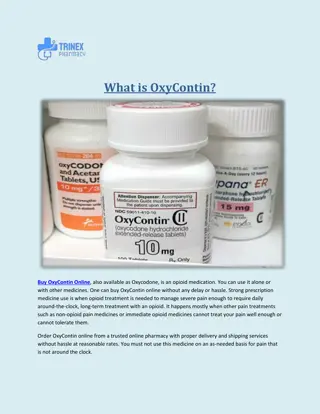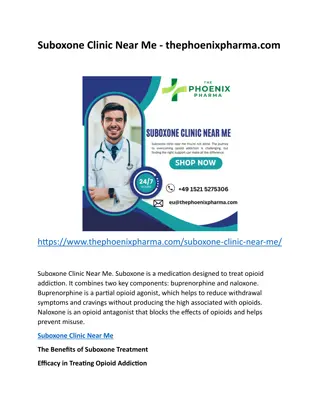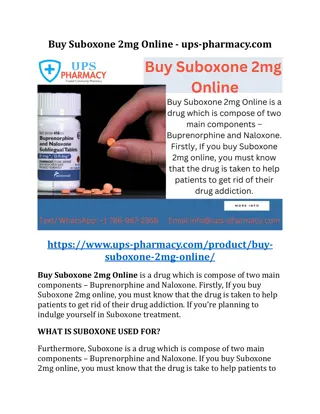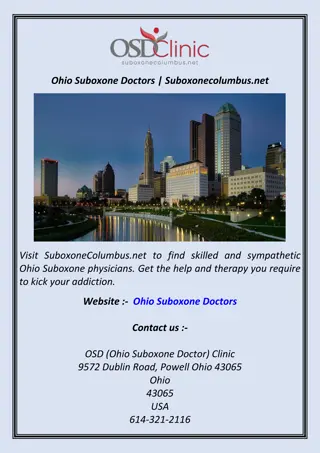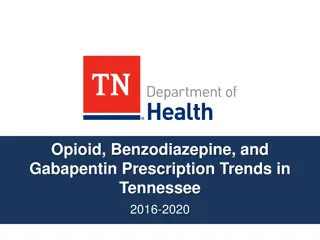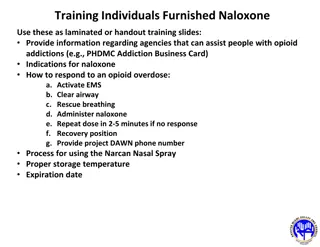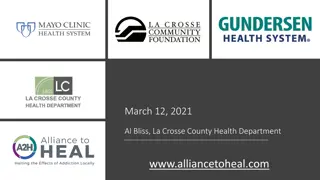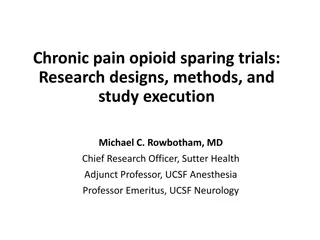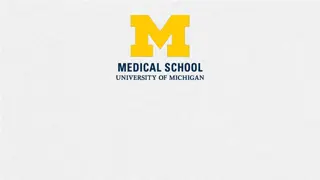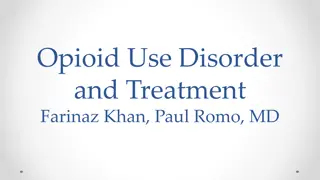Opioid Use Disorder and Suboxone Use in Family Practice
Deaths related to prescription opioids are a significant concern in Canada, with opioid-related mortality impacting individuals prescribed opioids. Monitoring long-term opioid therapy is crucial, and guidelines emphasize caution in opioid prescribing practices. Opioid use disorder is a predictable complication, highlighting the importance of interventions like Suboxone in family practice settings to address addiction and support recovery.
Download Presentation

Please find below an Image/Link to download the presentation.
The content on the website is provided AS IS for your information and personal use only. It may not be sold, licensed, or shared on other websites without obtaining consent from the author.If you encounter any issues during the download, it is possible that the publisher has removed the file from their server.
You are allowed to download the files provided on this website for personal or commercial use, subject to the condition that they are used lawfully. All files are the property of their respective owners.
The content on the website is provided AS IS for your information and personal use only. It may not be sold, licensed, or shared on other websites without obtaining consent from the author.
E N D
Presentation Transcript
Opioid use Disorder and Suboxone Use for FP Dr. Sharon Koivu Physician Consultant- Palliative Care, Supportive Team Addiction Recovery; London Health Sciences Centre, Associate Professor, Department of Family Medicine, Western University
Declaration No Conflict of Interest
Deaths due to Prescription Opioids 1/8 young adult (age 25-34) deaths in Canada is from prescription opioid use Approximately 1 of every 170 deaths in Ontario is now related to opioid use. Opioid-related deaths result in ~ 22,000 years of potential life lost annually, Death by drug overdose is 3xs higher than deaths due to motor vehicle crashes as a cause of unintentional deaths, (2012,London,ON:MLHU) Most deaths occur in people who were prescribed opioids
Opioid Related Mortality Most deaths occur in people who were prescribed opioids 56% dispensed an opioid in the 4 weeks prior to death 82% dispensed an opioid in the year prior to death Median number of opioid prescriptions in year prior to death 10 prescriptions
Opioid Use Disorder (Addiction) A predictable complication of prescribing opioids Occurs in 2-14% of all patients treated with opioids for chronic non-cancer pain Highest in patients on doses greater than 90 MME per day Comparable to nausea in frequency of side effects Being in pain does not prevent opioid use disorder
Opioid Use Disorder: DSM-5 Opioid Abuse, Opioid Dependence Replaced by Opioid Use Disorder
Monitoring Long-term Opioid Therapy- 2010 If adverse effects or ineffective by 200mg/day morphine equivalent consider rotating or stopping opioid NOT escalating.
CDC Guidelines-2016 The 2017 Canadian Guideline Clinicians should use caution when prescribing opioids at any dosage, should carefully reassess evidence of individual benefits and risks when increasing dosage to 50 morphine milligram equivalents (MME)/day,
CDC Guidelines-2016 The 2017 Canadian Guideline avoid increasing dosage to 90 MME/day or carefully justify a decision to titrate dosage to 90 MME/day.
Diversion The vast majority of opioids on the street started as legal prescriptions which have been diverted.
Diversion In 2011, London Police estimate as much as 50% of prescribed OxyContin was diverted. In 2016 50% of prescribed HydromorphContin may be diverted
Diversion 14 % of adolescents say they have used prescription opioids recreationally 75% got them from the medicine cupboard in their own home (OSDUHS 2011)
Avoiding Diversion What is the most common age demographic for prescription opioids to be diverted? under 20 20-30 30 -40 40-50 50-60 60-75 Over 75
Avoiding Diversion 60-75 Are you profiling appropriately?
Case 1 MR is a 39 year old female Diagnosed with fibromyalgia History of PTSD Meds: HydroMorph Contin 30 mg q8h Hydomorphone 8 mg q6h prn Gabapentin 300 mg q 8 h Lorazepam 1qhs and q6h prn
Case 1 Admitted to LHSC on 3 occasions with Tricuspid valve endocarditis
Case 2 JC is a 61 year old man Chronic low back pain Lost job as drywaller Recent dose escalation Meds: OxyNeo 80 mg tid Percocet 1-2 po q4 h prn
Case 3 ML 58 year old woman Diagnosed with beast cancer 8 years ago Live on Grey Street Meds: HydroMorph Contin 18 mg tid Tamoxifen Always polite thankful and never misses an appointment
Case 3 A Family Medicine Resident does an elective with you and does a urine Toxicology screen She test negative for opiates
Case 4 SC 42 yo male Diagnosed with osteoarthritis of knee from skiing injury Meds: HydroMorph Contin 30 mg tid x years Suffers from apathy, decreased libido
Case 5 MW is an 39 year old man Long history of OUD, injection drug use DOC has been HydromMorph Contin Meds: Suboxone 8-2mg daily Successfully in recovery x 18 months Requires elective surgery
Community-Based OUD Treatment: Options 1. 2. 3. Opioid Maintenance Programs with opioid agonist Structured Opioid Treatment(in controlled setting) Abstinence (after taper) Canadian Guidelines for Safe and Effective use of Opioids for Chronic Non-Cancer pain (2010) CDC Guideline for Prescribing Opioids for Chronic Pain United States, 2016 Recommendations and Reports / March 18, 2016 / 65(1);1 49
Opioid Agonist Therapy Known injection drug use Patient has a complication associated with injection drug use- eg. Tricuspid valve endocarditis Diversion while also using opioids Unable to follow structured opioid
Opioid Maintenance Programs with opioid agonist 1. Buprenorphine/Naloxone Better safety profile Less abuse potential Less diversion potential All physicians can prescribe 2. Methadone Recovery vs harm reduction
Patients on Suboxone Surgical Considerations
Avoid stopping Suboxone Minor surgery Patient has a history of injection drug addiction
Consider stopping Suboxone pre-op Using for reasons other than addiction-chronic pain, cancer Expecting severe post-operative pain History of difficult to control post-operative pain while on Suboxone
If decide to continue on Suboxone Do not miss doses, even on day of surgery May need additional doses of Suboxone above baseline immediately post-op May need higher doses of full opioid agonist analgesic than usually expected May need close monitoring for respiratory depression if full opioid agonist added
If decide to discontinue Suboxone pre- op Bridge with full opioid agonist analgesic Avoid previous drug of choice and oxycodone if patient has opioid uses disorder If high risk consider hospitalization to bridge pre-op. Must be off Suboxone at least 5 days May still require higher doses than average of full opioid agonist Consider adjuvants
Structured Opioids Concerns regarding possible misuse, running out early Dispense Frequent Small amounts 1 day-14 days Frequent urine tox screens Monitor closely for negative effects of opioids
When to Taper Patient requests opioid taper. Patient is maintained on opioids for at least 3 months, and there is no sustained clinically meaningful improvement in function Patient s risk from continued treatment outweighs the benefit(e.g. decreased function and increased risk for opioid-related toxicity from concurrent drug therapy or comorbid medical conditions)
When to Taper Patient has experienced a severe adverse outcome or overdose event Patient has a complication associated with opioids: Depression, fatigue, sleep apnea, sexual dysfunction, falls
When to Taper Patient has a substance use disorder Use of opioids is not in compliance with current guidelines If patient already on opioids without a proper trial revisit appropriateness Patient exhibits aberrant behaviors Suspected diversion
How to Taper Explain that tapering improves pain, mood and function Establish goal of taper Endpoint not necessarily abstinence Use scheduled doses Frequent dispensing
How to Taper May taper quickly if medically indicated such as overdose or for diversion (over 2-3 weeks) Generally negotiate with patient re rate of taper
How to Taper Tapering too quickly may lead to: Uncontrollable pain Withdrawal Craving Loss of buy-in to process Street drug use Injection drug use
How to Taper Slow taper for patients with no acute safety concerns. Start with a taper of 10% of the original dose per week and assess the patient s functional and pain status at each visit.
How to Taper Adjust the rate, intensity, and duration of the taper according to the patient s response (e.g. emergence of opioid withdrawal symptoms
How to Taper Taper by 10% every 6-8 weeks may be required Reassess patient before a reduction The rate may be slowed or paused while monitoring for and managing withdrawal symptoms Do not reverse the taper; it must be unidirectional Reflective on the positive Avoid focusing on pain Assess function Assess quality of life
How to Taper It may take months to years to prevent reactivating cravings/ drug seeking Slow and steady wins the race
How to Taper Advise re overdose if return to previous dose
Observe Watch for signs of unmasked mental health disorders (e.g. depression, PTSD, panic disorder) during taper, especially in patients on prolonged or high dose opioids.
Case 1 MR is a 39 year old female Diagnosed with fibromyalgia History of PTSD Meds: HydroMorph Contin 30 mg q8h Hydomorphone 8 mg q6h prn Gabapentin 300 mg q 8 h Lorazepam 1qhs and q6h prn
Case 1 Admitted to LHSC on 3 occasions with Tricuspid valve endocarditis Recommend: OAT
Case 2 JC 61 year old man Chronic low back pain Lost job as drywaller Recent dose escalation Meds: OxyNeo 80 mg tid Percocet 1-2 po q4 h prn
Case 2 Consider Use + diversion Recommend: Taper with Structured opioids OAT
Case 3 ML 58 year old woman Diagnosed with beast cancer 8 years ago Live on Grey Street Meds: HydroMorph Contin 18 mg tid Tamoxifen Always polite thankful and never misses an appointment
Case 3 A Family Medicine Resident does an elective with you and does a urine Toxicology screen She test negative for opiates Remember: Patients with bad diagnoses can have socio- economic influences Recommend: This is purely diversion: Discontinue
Case 4 SC 42 yo male Diagnosed with osteoarthritis of knee from skiing injury Meds: HydroMorph Contin 30 mg tid x years Suffers from apathy, decreased libido


